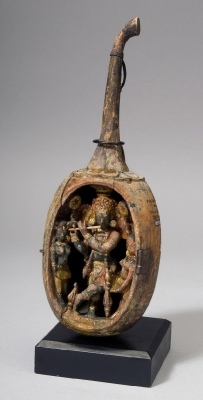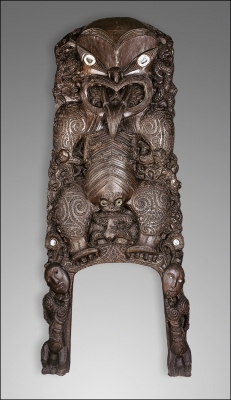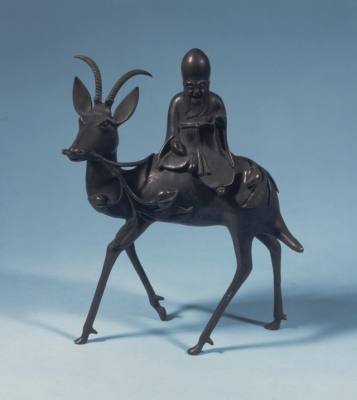To search the RPR site click here
How much did Pitt-Rivers spend on his founding collection?
The table included in the attached Word document shows the only objects for which the prices are known for items purchased by Pitt-Rivers for the founding collection. The second collection's prices are much better recorded. In general it is clear that Pitt-Rivers was correct when he said that he spent relatively little money on purchasing his first collection (at least, as compared to his second collection). However, he did spend sizeable sums from time to time as the table demonstrates.
Although Pitt-Rivers was infinitely more wealthy in 1881 than he had been before 1880 he had never been poor. After 1880 his annual income of around £20,000 per annum would have had the equivalence in ‘purchase power’ of £2,090,000 in 2009 (based on the same source and calculation as were used to calculate equivalent object costs, explained in the attached Word document for all object costs). Before 1880, however, he was still reasonably affluent. Bowden states that when he was an adult, but not earning a living from soldiering, he had an annual income of £1,000. [Bowden, 1991: 47]. This is the equivalent in ‘purchase power’ of £103,000 (if we take it that the base date is 1860) or £99,900 (if the base year was 1870) in 2009. [Note: the 1870 figure is correct, such presumably was the financial position in the 1870s that purchase power was reduced]
Pitt-Rivers reported that he spent a high percentage of his income on objects:
‘... I can ... say that my museum was formed at a time when my means of collecting were very small, and that it never cost me more than £300 a year at most.’ [Pitt Rivers, 1884a Dorchester address: 8]
Although Pitt-Rivers implies that £300 per annum was not a great deal in fact it was. It was also a very high percentage of his annual income, at around one third of his minimum recorded income (which suggests that Bowden's assessment of his annual income is an underestimate). £300 had the equivalent purchasing power in 2009 of around £30,000 per annum between 1860 and 1880. Even at today’s inflated art market prices £30,000 would buy a great deal and it is significantly more than the Pitt Rivers Museum’s annual purchasing budget today.
It is difficult to obtain information about the cost of archaeological and ethnographic items between 1850 and 1884. To put Pitt-Rivers’ budget in some perspective, Chapman discusses the costs of objects:
Medieval antiquities were still well beyond the financial reach of all but the very wealthy or profoundly dedicated. A suit of armour belonging to Samuel Meyrick, for example, sold for over £1,000 in the 1870s, and relatively undistinguished halberds or crossbows ran to well over £100. ... one anthropologist in 1874 could remember when a South Sea club, ‘not unlike our ancient weapons’, as he pointed out, costing £5 in Fiji could be obtained from the natives ‘for an empty beer or pickle bottle’. [Chapman, 1981: 41]
 The source of the latter information was an anonymous reviewer in the Journal of the Royal Anthropological Institute talking about the Godeffroy Museum collection, part of which came to Pitt-Rivers. [9 (1879), 462] Chapman suggests that he may have started to collect ethnographic material because, relatively speaking, its market value was lower in the mid nineteenth-century:
The source of the latter information was an anonymous reviewer in the Journal of the Royal Anthropological Institute talking about the Godeffroy Museum collection, part of which came to Pitt-Rivers. [9 (1879), 462] Chapman suggests that he may have started to collect ethnographic material because, relatively speaking, its market value was lower in the mid nineteenth-century:
‘Antique arms, particularly those of the Middle Ages, had enjoyed an enormous popularity throughout the first half of the nineteenth century ... medieval antiquities were still well beyond the financial reach of all but the very wealthy or profoundly dedicated ... [Pitt-Rivers] as a young and uninitiated collector dependent on his army pay and a small allowance from his mother, must simply have found the cost prohibitive. Exotic weapons, however, ... attracted few buyers and could be obtained quite cheaply.’[Chapman, 1981: 40]
I suspect that Chapman slightly underestimates his purchasing power but the point is valid. Pitt-Rivers himself suggested that he preferred to get ‘good value for money’ by purchasing low cost utilitarian objects:
‘I have confined myself mainly to common forms in which chiefly continuity can be traced, and have avoided giving large sums for rare things because such things do not fit into my series generally.’ [Pitt-Rivers to A.W. Franks, letter dated 27 June 1880 [Pitt Rivers Museum Foundation Box, Folio 3-4]
All his biographers seem to agree that Pitt-Rivers did not stint himself, particularly after receiving his inheritance, but that he was not a spend-thrift:
‘Pitt-Rivers is sometimes portrayed as a reckless spend-thrift but the accounts certainly do not bear this out ... Once we examine them and find that almost invariably his receipts exceeded his outlay then it is even more apparent that he kept a close hold on expenditure. If therefore he made a major purchase he had a clear knowledge of how this would affect his annual budget.’ [Thompson, 1977: 77]
Neither was he particularly a skinflint, a role which seems to have been reserved for his wife, according to Bowden at least. [Bowden, 1991: 33]
Around 130 items in the founding collection (roughly 0.7% of the founding collection) currently have documentation showing the price that was paid for them; these are detailed in attached PDF. Although there is the potential to increase this figure slightly (for example, by reviewing the auctioneer’s copy of the Sotheby’s sales held by the Bodleian Library in detail to try and identify Pitt-Rivers' purchases from 1851 to 1884) this would probably not lead to a great amount of additional information. There must be quite a few other items purchased from Sotheby in the founding collection, but unfortunately this is not recorded as Pitt-Rivers did not often note the source of his objects. Although he claimed that he most often obtained objects more directly; the second collection, and what information we have to hand, suggests throughout his collecting career he obtained most items from dealers and auction houses.
Of the items we do have information for; the lowest figure paid was 1 shilling and 6 pence (expressed in the style of the times as 1/6) [for 1884.127.66, a stone chisel from Denmark] and the highest £6.5.0 [for 1884.39.24, a pottery head from Cyprus]. In general, however, the prices are not particularly high.
Most of the objects listed appear to be the same types of ‘things’ but I think this is due to several different factors:
1. Musical instruments - the cost information is available because Balfour included these instruments in his detailed catalogues, otherwise it would not be recorded
2. Stone tools - many of these are identified as coming from Bryce Wright and it might be that some of the others were also obtained from him, or from another dealer. For some reason these items have retained documentation showing the purchase price (it may have been some peculiarity of Wright’s selling procedure).
It is unclear why the other items had the price information recorded.
There does not appear to be anything different about these artefacts (we have, for example plenty of other items from Bryce Wright which do not mention price) so it is not clear why the above items are the only ones with their price listed. A total of 951 objects from the founding collection are currently identified as having definitely been purchased, most of these do not have their purchase prices recorded, and currently their prices are not known.
The documentary sources for most of the prices given in the table are unclear. This is because the prices are usually found in the accession books, which were written some 40 years after the delivery of the founding collection. My current theory is that this information was sometimes written on the object or onto paper labels dating from before 188. This has yet to be confirmed, as only a few of the objects listed have notes which state that price information came from labels on the objects themselves. In each of these cases the information was provided on a paper label or written onto the object. However, the original accession book compiler (E.S. Thomas) must have obtained information from somewhere, and as it is definitely not provided in the other primary sources this is the last remaining place I can think of. If this supposition is correct, then when all founding collection objects have been catalogued in detail there should be more information about the prices Pitt Rivers paid for some items in the founding collection (this will not happen in the near future).
AP, November 2010, based on an earlier table and research carried out during the ESRC funded research project, Relational Museum.
Word document outlining the costs of putting together the founding collections





